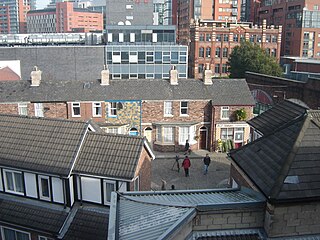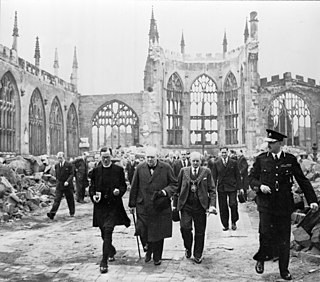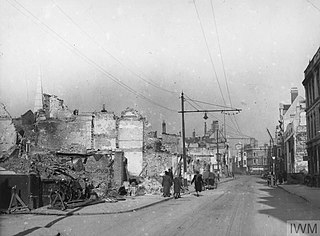Related Research Articles

Monongah is a town in Marion County, West Virginia, United States, situated where Booths Creek flows into the West Fork River. The population was 972 at the 2020 census. Monongah was chartered in 1891. Its name is derived from the nearby Monongahela River.

The M62 is a 107-mile-long (172 km) west–east trans-Pennine motorway in Northern England, connecting Liverpool and Hull via Manchester, Bradford, Leeds and Wakefield; 7 miles (11 km) of the route is shared with the M60 orbital motorway around Manchester. The road is part of the unsigned Euroroutes E20 and E22.

The Summerland disaster occurred when a fire spread through the Summerland leisure centre in Douglas on the Isle of Man on the night of 2 August 1973. 50 people were killed and 80 seriously injured. The scale of the fire has been compared to those seen during the Blitz.
On 11 May 2004, the ICL Plastics factory, in the Woodside district of Maryhill, Glasgow in western Scotland, exploded. Nine people were killed, including two company directors, and 33 injured, 15 seriously. The four-storey building was largely destroyed.

Hull Paragon Interchange is a transport interchange providing rail, bus and coach services located in the city centre of Kingston upon Hull, England. The G. T. Andrews-designed station was originally named Paragon Station, and together with the adjoining Station Hotel, it opened in 1847 as the new Hull terminus for the growing traffic of the York and North Midland (Y&NMR) leased to the Hull and Selby Railway (H&S). As well as trains to the west, the station was the terminus of the Y&NMR and H&S railway's Hull to Scarborough Line. From the 1860s the station also became the terminus of the Hull and Holderness and Hull and Hornsea railways.

The Birmingham Blitz was the heavy bombing by the Nazi German Luftwaffe of the city of Birmingham and surrounding towns in central England, beginning on 9 August 1940 as a fraction of the greater Blitz, which was part of the Battle of Britain; and ending on 23 April 1943. Situated in the Midlands, Birmingham, the most populous British city outside London, was considered an important industrial and manufacturing location. Around 1,852 tons of bombs were dropped on Birmingham, making it the third most heavily bombed city in the United Kingdom in the Second World War, behind London and Liverpool.

The Barnsley Public Hall disaster took place on Saturday 11 January 1908 in a public hall in Barnsley, West Riding of Yorkshire, England. It resulted in the deaths of sixteen children. At least 40 others were seriously injured. A number of children were entering the hall to see a show when a staircase became overcrowded, and there was a crush as they tried to get inside. The survivors were taken to Beckett Hospital.

The Royal Naval Cordite Factory, Holton Heath (RNCF) was set up at Holton Heath, Dorset, England, in World War I to manufacture cordite for the Royal Navy. It was reactivated in World War II to manufacture gun propellants for the Admiralty and its output was supplemented by the Royal Navy Propellant Factory, Caerwent. After the end of World War II, the explosive manufacturing areas of the site were closed down and some areas of the site reopened as the Admiralty Materials Laboratory. A major part of the explosives site became a nature reserve in 1981. Other parts of the site were converted into an industrial estate, and some may be used for housing.

The Huddersfield Royal Infirmary is a hospital situated in the English town of Huddersfield, part of Calderdale and Huddersfield NHS Foundation Trust. It is situated in the suburb of Lindley and provides general services, emergency services and some specialist services.

The sets of the British ITV soap opera Coronation Street have undergone four major and several less significant changes since the first broadcast in December 1960. Originally entirely indoors, in 1968 the original wooden set was moved outside, and shortly afterwards reconstructed in brick. In 1982 the set was entirely rebuilt in a new location. The current set, brought into use in 2013, is based at the ITV Trafford Wharf Studios backlot, MediaCityUK in Trafford.

The Silvertown explosion occurred in Silvertown in West Ham, Essex (now part of the London Borough of Newham on Friday 19 January 1917 at 6:52 pm. The blast occurred at a munitions factory that was manufacturing explosives for Britain's First World War military effort. Approximately 50 long tons of trinitrotoluene exploded, killing 73 people and injuring 400 more, as well as causing substantial damage in the local area. This was not the first, last, largest, or the most deadly explosion at a munitions facility in Britain during the war; an explosion at Faversham involving 200 long tons of TNT killed 105 in 1916, and the National Shell Filling Factory, Chilwell, exploded in 1918, killing 137.

The Coventry Blitz was a series of bombing raids that took place on the British city of Coventry. The city was bombed many times during the Second World War by the German Air Force (Luftwaffe). The most devastating of these attacks occurred on the evening of 14 November 1940 and continued into the morning of 15 November.

The Southampton Blitz was the heavy bombing of Southampton by the Nazi German Luftwaffe during World War II. Southampton was a strategic bombing target for the Luftwaffe as it contained both busy docks with associated business premises and factories and the Supermarine factory building Spitfires in Woolston. Being a large port city on the south coast it was within easy reach of German airfields in France.
Barnbow was a small settlement situated near the city of Leeds in the township and parish of Barwick in Elmet. The site is noted as the location of a munitions factory founded during the First World War. It was officially known as National Filling Factory No. 1. In 1916 a massive explosion killed 35 of the women who worked there.
The Cadeby Main Pit Disaster was a coal mining accident on 9 July 1912 which occurred at Cadeby Main Colliery in Cadeby, West Riding of Yorkshire, England, killing 91 men. Early in the morning of 9 July an explosion in the south-west part of the Cadeby Main pit killed 35 men, with three more dying later due to their injuries. Later in the same day, after a rescue party was sent below ground, another explosion occurred, killing 53 men of the rescue party.

Crewe War Memorial stands in the Municipal Square, in Crewe, Cheshire, England. It consists of a bronze sculpture of Britannia standing on a pedestal, itself on a square base. The sculptor was Walter Gilbert and the sculpture was cast in the foundry of H. H. Martyn & Co. It was unveiled in 1924. The names of those killed in both world wars and in later conflicts are inscribed on bronze plaques around the base, and there are further inscriptions on the paving around the memorial. It originally stood in Market Square and was moved to Municipal Square in 2006. The memorial is recorded in the National Heritage List for England as a designated Grade II listed building.

The Port Sunlight War Memorial stands in a central position in the model village of Port Sunlight, Wirral, Merseyside, England. The founder of the village and employer of its residents, William Lever, was anxious to have a memorial to commemorate those of his workers who had been lost in the First World War. As early as 1916 he commissioned Goscombe John to design a war memorial, which was completed and unveiled in 1921 by two of his employees. It consists of a granite runic cross with bronze statues and reliefs and has the theme "Defence of the Realm". On the memorial are the names of all of the company's employees who died as a result of both World Wars. It is recorded in the National Heritage List for England as a designated Grade I listed building.

The Bootle War Memorial is in King's Gardens, Stanley Road, Bootle, Sefton, Merseyside, England. It was paid for partly by a grant from the local council, and partly by public subscription. The sculptor was Herman Cawthra, with assistance in the design from Hubert Ernest Bulmer, the borough's art director. The monument consists of a mother and child on top of an obelisk, which is surrounded by the figures of three servicemen. It was unveiled in 1922, and the names of those killed in the Second World War were added in 1948. The memorial was recorded in the National Heritage List for England as a designated Grade II listed building in 1986, and upgraded to Grade II* in 2018.

Drummond Mill was a complex of industrial buildings on Lumb Lane, Manningham, Bradford, West Yorkshire. It contained originally a spinning mill, a warehouse, a spinning shed, and an engine house with chimney and was destroyed in a fire on 28 January 2016.
References
- ↑ "Booths Factory Fire, Huddersfield, 1941". Archived from the original on 23 May 2014. Retrieved 6 May 2014.
- ↑ 1941 Booth’s fire victims did not die in vain, says firefighter
- ↑ Booth’s Memorial
- ↑ Memorial for 49 killed in Huddersfield factory fire
- 1 2 "Permanent memorial to Booth's factory fire in Huddersfield unveiled". Huddersfield Examiner. 5 November 2012. Retrieved 24 April 2018.